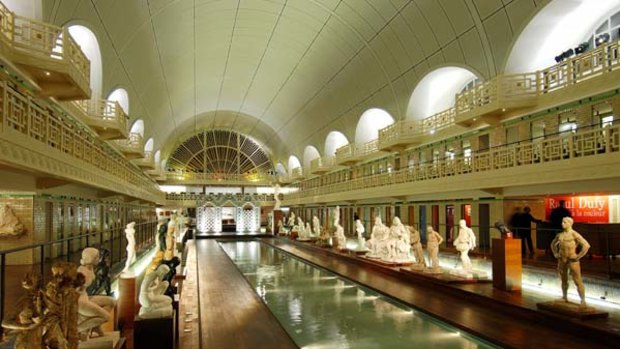
Next stop ... Lille's attractions include the museum La Piscine in nearby Roubaix.Credit: AFP
It has been a rather embarrassing northern winter for Eurostar, whose usually reliable cross-channel rail service has been dogged by a catalogue of breakdowns and complaints from angry passengers.
I guess I was one of the lucky ones. A few days after hundreds of people found themselves stranded in the Channel Tunnel, my train rolled out of London St Pancras station and, exactly 80 minutes later, we were pulling into Lille, on time and without a hitch.
Despite being the closest foreign city to Britain, Lille is often ignored by travellers, who tend to use the Eurostar to dash straight to Paris. It's perhaps understandable. The French capital is only another hour away on the high-speed line but Lille is definitely worth a look.
True, it can't boast the kind of world-famous sights for which Paris is known (there's a nice belfry but no Eiffel Tower), yet it makes up for it in other ways - and not only because it's less pretentious, far kinder on the wallet and free of pestering touts.
While Lille's outskirts are industrial, its centre is a beauty. A pleasant 10-minute walk from the Gare Europe station, and its adjacent futuristic-looking hyper-market, is the city's heart, the large, postcard-pretty central square, which was named Place du General de Gaulle after the former French president, who was born in Lille in 1890.
The square is fringed with ornate 17th- and 18th-century buildings and, when I visited, people were casually ambling across it eating baguettes, while filling the air with French greetings ("Bonjour Madam! Bonjour Monsieur!").
Lille is not the most typically French of cities, though. Lying just 20 kilometres from the Belgian border, it was once part of the County of Flanders, which encompassed swathes of northern France as well as Dutch and Flemish-speaking Belgium. As a result, both French and Flemish influences are evident in everything from Lille's diverse gastronomy to its glorious architecture. A prime example of this enticing French-Flemish hybrid is Vieux Lille, a labyrinth of cobbled streets, winding alleyways and quaint little squares.
Perfect for sauntering through, the neighbourhood has many restored Flemish guild-houses, built with the proceeds of the booming mediaeval wool trade, but which are now home to boutiques, art and antique galleries and an astonishing number of places in which to eat, drink and be merry.
Some of the family-run patisseries and chocolatiers serving croissants, sweets and waffles attract queues that stretch out into the streets.
Lille is said to have about 900 restaurants, including scores of typically sophisticated French bistros and brasseries, but I was drawn to the traditional Flemish establishments, which in these parts are called estaminets.
Popular with locals, Le Rijsel oozes character and doubles as a cosy pub and restaurant, with home-brewed beers and meaty Flemish fare on the menu. At my rustic, candle-lit wooden table, I ate delicious pot'je vleesch (a terrine of chicken, veal and rabbit) and enjoyed draught blonde Ch'ti beer.
Like many estaminets, Le Rijsel's decor features old framed paintings and photographs, tradesmen's signs and general clutter from yesteryear, including hanging wicker baskets, pots and pans and a ceiling draped with dried hops.
Afterwards I checked out Omnia, a bar-restaurant with an excellent cocktail and wine selection, a colourful history and more of a French feel. The interior - characterised by seductive red lighting and cushioned booths - looks like a set from Moulin Rouge!; indeed, a waitress tells me, it was once a theatre, then a brothel and, finally, a porn cinema before its present incarnation.
Lille has several cultural sights, including the Palais des Beaux-Arts, which showcases, among many others, Flemish and Dutch masters such as Van Dyck and Rubens. It's regarded as France's best fine arts museum after Paris's Louvre.
Elsewhere, the neoclassical opera house hosts regular concerts and dance performances, there's an interesting museum about president de Gaulle in the house in which he was born and the city's Notre Dame cathedral melds original neo-gothic architecture with a striking modern facade.
Close to Lille are World War I battlefields and cemeteries including Ypres, which is just across the Belgian border, and, 17 kilometres west of Lille, the French village of Fromelles, in which a new war-grave site commemorating hundreds of British and Australian soldiers was recently unveiled. Their bodies were dumped in mass graves by German troops after the 1916 Battle of Fromelles, to be rediscovered by archaeologists in 2008. You'll need to hire a car - or join a tour - to visit these sights.
If you prefer modern art to war history, hop on Lille's cool, driverless metro to reach the town of Roubaix, home to one of France's quirkiest museums. Housed in a former municipal swimming pool, La Piscine hosts exhibits and paintings in old shower cubicles and bathrooms, while the centrepiece is the old pool itself.
Lined on each side by impressive statues and sculptures, it's bathed in light from two beautiful stained-glass windows, casting a magical red and orange glow over the room.
La Piscine rounds off a stopover full of pleasant surprises. Next stop: Paris.
The writer was a guest of Eurostar and Lille Tourism.
TRIP NOTES
GETTING THERE
Eurostar has one-way fares from London to Lille from £32.50 ($53). See eurostar.com. TGV trains run regularly from Lille to Paris. See tgv.com.
WHERE TO STAY
The Couvent des Minimes Alliance Lille, a four-star hotel set in a gorgeous former 17th-century convent has doubles from about €162 ($243). See alliance-lille.com.
WHERE TO EAT
Le Rijsel, 25 Rue de Gand, phone + 33 3 2015 0159, see estaminetrijsel.com.
Omnia, 9 Rue Esquermoise, phone + 33 3 2057 5566, see omnia-restaurant.com.
FURTHER INFORMATION
Lille Tourist Office operates a Flanders battlefields tour from Lille to Ypres, in English, every Saturday from April to December for €38 a person. See lilletourism.com.
Sign up for the Traveller Deals newsletter
Get exclusive travel deals delivered straight to your inbox. Sign up now.